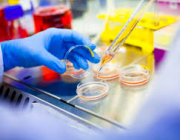Citation:
Badis DAIKH, Omar BENOUNE. The effectiveness of platelet-rich plasma on the skin wound healingprocess: A comparative experimental study in sheep. Veterinary World, [Internet]. 2018;Vol.11 (2231-0916) :800-808.
| plasma riche en plaquettes | 2.34 MB |
Abstract:
Aim: The therapeutic evaluation of the biological effect of platelet-rich plasma (PRP) used as a surgical adjunct to maintainthe inflammatory process and to potentiate tissue healing, make the subject of recent research in regenerative medicine. This
study was designed to evaluate the healing activity of PRP by its topical application on the skin experimentally injured in
a sheep model.
Materials and Methods: The study was conducted on 9 adult and clinically healthy males sheep. PRP was obtained by a
protocol of double centrifugation of whole blood from each animal. After sterile skin preparation, full-thickness excisional
wounds (20 mm x 20 mm) were created on the back of each animal. The animals were randomly divided into three equal
groups of three sheep for each. In Group I, the wounds were treated with PRP, in Group II; wounds were treated with
Asiaticoside; in Group III, wounds were treated with saline solution. The different treatments were administered topically
every 3 days. Morphometric measurements of the contraction surface of the wounds and histopathological biopsies were
carried out at the 3rd, 7th, 14th, 21st, and 28th days of healing.
Results: The results of the morphometric data obtained revealed that it was significant differences recorded at the 7th and
14th day of healing in favor for animals of Group I. Semi-quantitative histopathological evaluation showed that PRP reduces
inflammation during 3 first days post-surgical and promotes epithelialization in 3 weeks of healing.
Conclusion: We concluded that topical administration of PRP obtained by double centrifugation protocol could potentially
improve the skin healing process in sheep.
